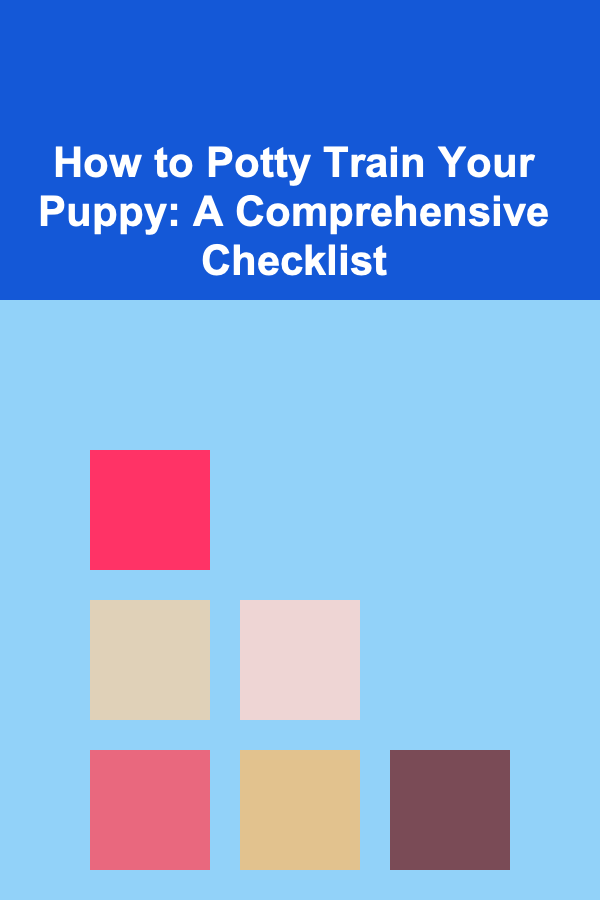
How to Potty Train Your Puppy: A Comprehensive Checklist
ebook include PDF & Audio bundle (Micro Guide)
$12.99$9.99
Limited Time Offer! Order within the next:

Potty training a puppy is one of the most important aspects of dog ownership. It not only ensures that your home stays clean, but it also sets the foundation for a strong relationship with your new furry friend. While potty training can sometimes be challenging, it is absolutely achievable with consistency, patience, and the right strategies.
This comprehensive guide will cover everything you need to know about potty training your puppy, including understanding the basics, creating a training schedule, common mistakes to avoid, and tips for success. Whether you are a first-time puppy owner or looking for ways to improve your current approach, this guide will provide you with all the information you need.
Understanding Potty Training Basics
Why Potty Training is Essential
Potty training is crucial because it helps your puppy understand where it is appropriate to relieve itself. Without proper potty training, your puppy might go to the bathroom in unwanted areas of your home, leading to frustration for both you and your dog. Additionally, proper potty training helps foster good habits and ensures that your puppy grows up to be well-behaved.
Dogs are naturally clean animals, and they don't want to relieve themselves in their living space. Potty training taps into this instinct, allowing you to teach your puppy how to go to the bathroom in the correct spots, whether it's outside in the yard, in a designated potty area, or on potty pads.
When to Start Potty Training
You can start potty training your puppy as early as eight weeks old. Puppies are usually ready to learn at this stage, and they have the physical ability to hold their bladder for short periods of time. However, keep in mind that puppies have small bladders and may need to go outside more frequently than adult dogs. Most puppies are fully potty trained by 4 to 6 months, but the process can take time and varies from dog to dog.
Key Concepts in Potty Training
Before diving into the specifics of potty training, it's important to understand a few core concepts:
- Consistency: Consistency is essential in potty training. Your puppy needs to understand that the same rules apply every time they go to the bathroom. This includes sticking to a routine, using the same potty area, and rewarding good behavior consistently.
- Positive Reinforcement: Reinforcing positive behavior with rewards such as praise, treats, or playtime will help your puppy associate potty training with something positive.
- Supervision: During the training period, you need to keep a close eye on your puppy to prevent accidents and provide immediate feedback.
- Patience: Potty training takes time, and each puppy learns at its own pace. Patience and understanding are key to avoiding frustration and setting your puppy up for success.
Step-by-Step Potty Training Guide
Step 1: Create a Potty Schedule
A consistent potty schedule is the cornerstone of successful potty training. Puppies thrive on routine, so setting specific times for potty breaks will help them learn where and when they should go. Here's a basic potty schedule to follow:
- First thing in the morning: After your puppy wakes up, take them outside immediately.
- After meals: Puppies need to go potty shortly after eating, so take your puppy outside within 15 to 30 minutes of their meal.
- After naps: Like after waking up, puppies need to go potty after naps.
- Before bedtime: Make sure to take your puppy outside right before bed to avoid any accidents overnight.
- Every 2 to 3 hours: Puppies have small bladders, so take them outside frequently throughout the day, especially if they are under 6 months old.
Step 2: Choose a Designated Potty Spot
Choosing a specific spot for your puppy to go potty is essential. This could be a corner of the yard, a grassy area, or a designated potty pad indoors. It's important to stick to this spot every time. Dogs learn to associate certain scents with bathroom time, and using the same location helps reinforce the idea.
- Outdoors: If you're potty training your puppy to go outside, take them to the same spot each time. The familiar scent will prompt them to relieve themselves there.
- Potty Pads: If you're using indoor potty pads, place the pad in a consistent location. Over time, you can gradually move it closer to the door if you plan to transition your puppy to outdoor potty training.
Step 3: Supervise and Confinement
When you're not actively training your puppy, it's essential to supervise them to prevent accidents. Use a crate or a confined area where they can't roam freely but have enough room to move around comfortably. Crate training is a valuable tool in potty training because dogs instinctively avoid soiling their living space. The crate should not be used as punishment, but as a safe and comfortable environment.
- Crate Training: Crates work well because puppies typically avoid relieving themselves in a confined space. However, the crate should only be used for short periods. Long confinement can lead to discomfort or accidents, so be sure to take your puppy outside frequently.
- Supervision: If your puppy is not in a crate, you should supervise them constantly. If they start sniffing around or walking in circles, it's a sign they might need to go outside.
Step 4: Reward and Praise for Positive Behavior
When your puppy successfully goes potty in the right place, immediately reward them with positive reinforcement. This could include praise, a treat, or a fun play session. The reward must come right after the behavior so that your puppy can make the connection between the action and the reward.
- Verbal Praise: Say "Good boy/girl" in an enthusiastic and positive tone to let your puppy know they did well.
- Treats: Offer a small treat as a reward to reinforce the behavior. You can start with small treats and gradually phase them out as your puppy becomes more reliable.
- Playtime: Some puppies respond well to a quick play session as a reward. Playtime can be a great motivator for energetic dogs.
Step 5: Deal with Accidents Calmly
Accidents are bound to happen during the potty training process, especially in the early stages. It's important not to punish your puppy for accidents, as this can create fear and confusion. Instead, clean up the mess promptly and try to prevent it from happening in the future by closely supervising your puppy.
- Never punish your puppy: Punishing your puppy for accidents can lead to confusion and fear, making it harder to train them in the long run.
- Clean thoroughly: Use an enzymatic cleaner to remove all traces of urine or feces. This will prevent your puppy from being attracted to the same spot again due to the scent.
- Redirect: If your puppy has an accident inside, take them outside immediately to their designated potty area. This teaches them that outside is the proper place to go.
Step 6: Be Patient and Consistent
Potty training doesn't happen overnight. It can take weeks or even months for your puppy to be fully trained, depending on their age, temperament, and consistency. Stay patient, and remember that puppies learn at different rates. The key to success is consistency---stick to the routine, supervise your puppy, and reward positive behavior.
Common Mistakes to Avoid
While potty training, there are several mistakes that can slow down progress. Here are a few common pitfalls to avoid:
- Inconsistent Scheduling: Not sticking to a regular potty schedule can confuse your puppy and hinder progress.
- Punishing for Accidents: Negative reinforcement, such as yelling or rubbing a puppy's nose in their mess, is counterproductive and can damage the relationship you share with your puppy.
- Not Giving Enough Bathroom Breaks: Puppies have small bladders and need frequent potty breaks. Failing to give your puppy regular opportunities to go outside can lead to accidents.
- Not Cleaning Accidents Thoroughly: If you don't clean up accidents properly, your puppy may return to the same spot and potty again.
- Overloading with Too Much Training at Once: Trying to teach your puppy too much at once can cause frustration and confusion. Break the training process into small, manageable steps.
Troubleshooting Common Potty Training Problems
Problem 1: Your Puppy Keeps Having Accidents in the House
If your puppy continues to have accidents inside, it may be due to one of the following reasons:
- Too much freedom: If your puppy is given too much freedom in the house too soon, it can lead to accidents. Make sure to supervise them or use a crate for confinement when you're not actively training.
- Inconsistent schedule: If you're not sticking to a consistent potty schedule, your puppy may not learn when it's time to go.
- Health issues: In some cases, frequent accidents can be a sign of an underlying health problem, such as a urinary tract infection. If you suspect this, consult your veterinarian.
Problem 2: Your Puppy Is Reluctant to Go Outside
Some puppies are hesitant to go outside for potty breaks, especially if they're scared or unfamiliar with the environment. Here are a few tips to help:
- Create a positive association with going outside: Take your puppy outside regularly, even if they don't need to go. Praise them when they explore the yard or walk around.
- Be patient: If your puppy is hesitant, give them time. Avoid pressuring them, and let them take their time to feel comfortable.
Final Thoughts
Potty training is a crucial aspect of raising a well-behaved and happy puppy. By following the steps outlined in this guide and maintaining consistency, patience, and positive reinforcement, you will help your puppy learn where and when to go potty. Remember that accidents are a normal part of the process, and every puppy learns at their own pace. Stay patient, and enjoy the journey of raising a well-trained puppy.
Reading More From Our Other Websites
- [Organization Tip 101] How to Curate a Capsule Wardrobe with Luxury Pieces
- [Home Budget 101] How to Reduce Home Energy Costs: Simple Fixes for a More Efficient Home
- [Needle Felting Tip 101] Troubleshooting Common Mistakes When Needle Felting Feline Features
- [Digital Decluttering Tip 101] Living Light Online: Strategies to Cut Screen Time Without Missing Out
- [Personal Financial Planning 101] How to Prepare for a Comfortable Retirement in Your 30s
- [Home Soundproofing 101] How to Soundproof a Home Office on a Budget
- [Home Budget Decorating 101] How to Decorate Your Home with Inexpensive Throw Pillows and Blankets
- [Organization Tip 101] How to Organize Dress-Up Clothes for Imaginative Play
- [Home Rental Property 101] How to Select an Apartment with a Pool for a Perfect Summer Rental
- [Home Budget 101] How to Budget for Senior Home Care Needs and Unexpected Expenses

How to Add Holiday Cheer to Your Bathroom with Simple Decor
Read More
How to Clean and Maintain Your Coffee Maker
Read More
How to Clean and Maintain Your Home's Chimney
Read More
How to Conduct a Home Inventory for Insurance Purposes
Read More
How to Make Money Online as a Dropshipper: 10 Actionable Ideas
Read More
How to Write Meditation Scripts Incorporating Nature Imagery
Read MoreOther Products

How to Add Holiday Cheer to Your Bathroom with Simple Decor
Read More
How to Clean and Maintain Your Coffee Maker
Read More
How to Clean and Maintain Your Home's Chimney
Read More
How to Conduct a Home Inventory for Insurance Purposes
Read More
How to Make Money Online as a Dropshipper: 10 Actionable Ideas
Read More